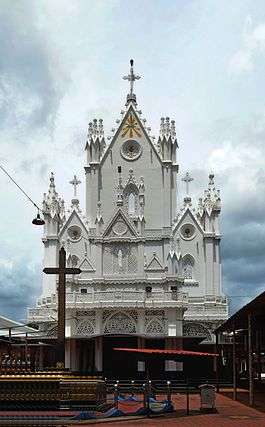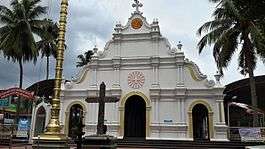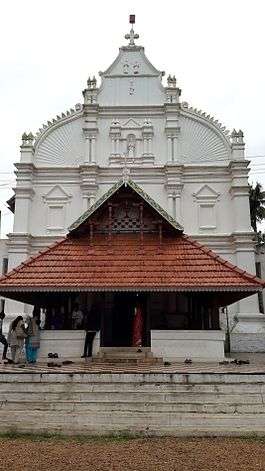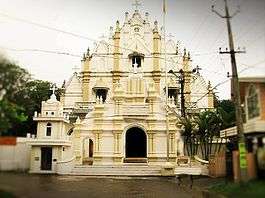Malankara Jacobite Syrian Orthodox Church
| Malankara Jacobite Syrian Orthodox Church | |
|---|---|
|
Syriac Orthodox Church Emblem | |
| Independence | Apostolic Era |
| Recognition | Oriental Orthodox |
| Primate | Catholicos Baselios Thomas I |
| Headquarters | Kochi, India |
| Territory | India |
| Possessions | India, Europe, Australia, New Zealand, and North America |
| Language | Malayalam, English, Hindi, Syriac |
| Members | 1.2 Million[1](2003 CE) |
| Website | jscnews.org |

The Malankara Jacobite Syrian Orthodox Church,[2][3][4][5][6] officially known as Jacobite Syrian Christian Church,[7][8][9][10] is an integral branch of the Syriac Orthodox Church centered in Kerala, India. It recognizes the Syriac Orthodox Patriarch, currently Ignatius Aphrem II, as its supreme head. It functions as a largely autonomous unit within the church, under the authority of the Catholicos of India, currently Baselios Thomas I. Its members are part of the Saint Thomas Christian community, which traces its origins to the evangelistic activity of Thomas the Apostle in the 1st century.[11][12][13][14] Thomas the Apostle reached India in AD 52 and got followers from prominent families in Kerala. In AD 345 Knai Thoma along with 72 Syrian Families and Clergymen arrived Kerala and mark the beginning of Knanaya Syrian Ethnicity in Kerala. In AD 825 arrival of two bishops Mar Sabor and Mar Aproth enhances the relationship between Nasrani community of Kerala and Syrian Christian Liturgy. The local administration of the early Nasrani (Syrian Christian) Community in Kerala was done by Archdeacons in the absence of a bishop. Archdeacons used to request for prelates from the Holy Throne of Antioch and all the East who can provide spiritual guidance to the local community.
From the 16th century the Portuguese Jesuits attempted to forcefully bring the community into the Latin Rite of the Catholic Church. On hearing about the persecution suffered by his flock in Malankara, the Patriarch of Antioch, Mor Ignatius Hidayat Aloho, set out to Malankara in 1653. Since Portuguese could not say the name "Hidayat Aloho" they called him "Ahathalla". He was captured by the Portuguese enroute and was taken to Madras. Resentment of these measures lead a part of the community to join the Archdeacon, Thomas, in swearing never to submit to the Portuguese in the Coonan Cross Oath in 1653. The part of the church that resists the Latin power is known as the Malankara Syrian Orthodox Church.
Following Mar Ignatius Hidayat Aloho, Mar Gregorios Abdal Jaleel Patriarch of Jerusalem arrived Malankara in 1665, to reinforce the original syrian liturgy in malankara and the relationship with the Syriac Orthodox Church liturgy of Antioch. In AD 1876 the synod of Mulamthuruthy constituted the democratic procedures and practices of the Malankara church in the presence of the Syriac Orthodox Patriarchs Ignatius Peter IV (reigned 1872—1894) and Joseph Mar Divanyasious V and representatives from all the local churches. The dicisions taken by the Holy Synod of Mulamthuruthy known as Mulanthuruthy Padiyola, is the most important historical document and the early constitution of the Malankara Syrian Orthodox Church. Mar Divanyasious VI (the successor of Mar Divanyasious V), start taking monopolies decisions without discussing with the civilian trustees of the church, which disturb the democratic coordination of the church and lead to split in the church. In 1912, a synod led by the Patriarch Ignatius Abdul Masih II, who had been controversially deposed by the Ottoman government, consecrated Evanios as Catholicos of the East, under the name Mar Baselios Paulose I. The faction that supported Baselios Paulose became what is now the Malankara Orthodox Syrian Church, while those who supported the new Patriarch Ignatius Abded Aloho II became the Jacobite Syrian Orthodox Church.[15][16] In 1934 after the death of Mar Divanyasious VI Syriac Orthodox Patriarchs Ignatius Elias III consecrated Paulose Mar Athanasius as the Malankara Metropolitan. At the same time Mar Themothiose Augen I left that faction and joined the faction of Malankara Church which submitted to the authority of Baselios Geevarghese II as Catholicos of the East.
Church leaders made several attempts at reunification in the mid-20th century, leading to two Supreme Court decisions, but were unable to resolve the contention, and the two churches operate independently today.[17][18][19] By the end of March 1966, Mar Themothiose Augen I declared Mar Elia Chapel, Kottayam as the official Thronal Cathedral of the Catholicos of the East. The headquarters of the Jacobite Syrian Christian Church in India is situated near the St. Peter's and St. Paul's Jacobite Syrian church Puthencruz.
As part of the Syriac Orthodox communion the church uses the West Syrian liturgy and is part of the Oriental Orthodox group of churches. It has dioceses in most parts of India as well as in the United States, Canada, the United Kingdom, Western Europe, and the Persian Gulf nations. In 2003 it was estimated that the church has 1,200,000 members globally.[17]
Name
The Malankara Jacobite Syrian Orthodox Church has been known by several names during its existence. Other variants include Jacobite Syrian Christian Church,[20] Malankara Syrian Orthodox Church, and Jacobite Syrian Church.[21]
Headquarters
Puthencruz is the headquarters of the Jacobite Syrian Christian Church in India. The headquarters is situated near the St. Peter's and St. Paul's Jacobite Syrian church. Its headquarters is named after the illustrious Patriarch of Antioch Ignatius Zakka I Iwas. The property was bought and built under the leadership of the Catholicos of India Mar Baselios Thomas I, after the church faced difficulties in continuing its functioning from its base at Muvattupuzha with the demise of Catholicos Mar Baselios Paulose II. Within a short time this religious centre rose to significance inside the community and state.
The Catholicossate chapel is named after Poulose Mar Athanasius of Aluva and under the chapel is situated the space for tombs for the use of future Catholicos of the church. An Arts and Science college named after Mar Athanasius of Aluva is also run in the premises of the Zakka centre. It is the place where Akhila Malankara Suvisesha Yogam, the official gospel convention of the community, that is generally conducted from 26 to 31 December of every year. The official publishing house of the church, JSC Publishers are also a part of the large complex.Its subsidiary institutions such as the Malankara Jacobite Syrian Sunday School Association (MJSSA) is also based in Puthencruz.
History

Thomas the Apostle is credited by tradition for founding the Indian Church in 52 AD.[17][22][23][24] This "Nasrani" faith had many similarities to ancient Judaism, see also Jewish Christianity, and owing to the heritage of the Nasrani people, developed contacts with the Nestorian religious authorities of Edessa, Mesopotamia.
The local church maintained its autonomous character under its local leader. When the Portuguese established themselves in India in the 16th century, they found the Church in Kerala as an administratively independent community. Following the arrival of Vasco de Gama in 1498, the Portuguese came to South India and established their political power there. They brought missionaries to carry out evangelistic work in order to establish churches in communion with Rome under the Portuguese patronage. These missionaries were eager to bring the Indian Church under the Pope's control. They succeeded in their efforts in 1599 with the Synod of Diamper. The representatives of various parishes who attended the assembly were forced by Portuguese authorities to accept the Papal authority.
Following the synod, the Indian Church was governed by Portuguese prelates. They were generally unwilling to respect the integrity of the local church. This resulted in disaffection which led to a general revolt in 1653 known as the "Coonan Cross Oath".Under the leadership of their elder Thomas, Nazranis around Cochin gathered at Mattancherry church on Friday, 24 January 1653 (M.E. 828 Makaram 3) and made an oath that is known as the Great Oath of Bent Cross. The following oath was read aloud and the people touching a stone-cross repeated it loudly. By the Father, Son and Holy Spirit that henceforth we would not adhere to the Franks, nor accept the faith of the Pope of Rome.[25] This reference from the The Missionary Register of 1822 seems to be the earliest reliable document available. Those who were not able to touch the cross tied ropes on the cross, held the rope in their hands and made the oath. Because of the weight it is believed by the followers that the cross bent a little and so it is known as "Oath of the bent cross" (Coonen Kurisu Sathyam). This demanded administrative autonomy for the local church. Since it had no bishop, it faced serious difficulties. It appealed to several eastern christian churches for help. The Syrian Patriarch of Antioch responded and sent the metropolitan bishop Gregorios Abdal Jaleel of Jerusalem to India in 1665. He regularized the canonical ordination of Marthoma I as a bishop and worked together with him to organize the Malankara church.
Catholicos of India
Catholicose of India is an ecclesiastical office in the Syriac Orthodox Church, the head of the Jacobite Syrian Christian Church in Kerala, India. He is the Catholicos/Maphrian of the Jacobite Syrian Christian Church an autonomous body within the Syriac Orthodox Church, and functions at an ecclesiastical rank second to the Syriac Orthodox Patriarch of Antioch. The jurisdiction of the Syriac Orthodox Catholicos is limited to India and Indian diaspora, although he is often invited to preside over Syriac Orthodox functions abroad.[26] The current Catholicos of India is Catholicos Baselios Thomas I, who was consecrated in 2002.
The position was created in the 20th century, amid a series of splits within the local Malankara Church and the broader Syriac Orthodox communion that divided the community into rival Jacobite Syrian and Indian Orthodox factions. It was instituted to provide a regional head for Jacobite Syrian Church, the faction that remained closely aligned with the Patriarch of Antioch.
Catholicos Baselios Thomas I (Mal: ആബൂന് മോര് ബസേലിയോസ് തോമസ് പ്രഥമന് കാതോലിക്ക ബാവ, b: July 22, 1929) is the second Maphrian i.e. Catholicos of the Syriac Orthodox Church in India and Metropolitan Trustee of the Jacobite Syrian Christian Church.
His official title is Catholicos of India. On 26 July 2002 he was enthroned as the second Catholicos and the head of the Malankara Jacobite church in India by the Patriarch Ignatius Zakka I Iwas, in a ceremony held in Damascus, Syria. The position had remained vacant between 1996 (date of death of Catholicos Baselios Paulose II) and 2002.
Saints of the Church
- Ignatius Elias III - Patriarch Of Antioch (Entombed in Manjanikkara Dayara at omallur)
- Mor Baselios Yeldo - Catholicos of Persia (Entombed in Kothamangalam cheria pally)
- Parumala Thirumeni (Geevarghese Mor Gregorious, Entombed in Parumala Church)
- Paulose Mar Athanasius - Methropolitian of Jacobite Syrian Church (entombed in Aluva Thrikkunnathu Seminary )
- Mor Koorilos Paulose - Malankara Metropolitan (Entombed in Panampady Church)
- St.Kooorilos Yuyakkim - Reesh-Episcopa of Malankara (Entombed in Mulanthuruthy Marthoman Church )
- St.Osthatheos Sleeba - Apostolic delegate of the Holy See to India ( Entombed in Arthat St.Mary's Simhasana church, Kunnamkulam )
- Baselios Sakralla III of Aleppo - Maphryono (entombed at Morth Mariam Cathedral,Kandanad)
- Gregorios Abdal Jaleel - Syrian Orthodox Metropolitan of Jerusalem (entombed at St. Thomas Church North Paravur)
Dioceses
The Jacobite Syrian Orthodox Church has the following dioceses

Archdioceses (Autonomous)
There are Archdioceses under the jurisdiction of the Patriarch of Antioch:
- Knanaya Archdiocese
- Region of Chingavanam
- Region of Kallisseri
- Region of Ranni
- Region of USA, Canada and Europe
- Malankara Archdiocese of North America
- Malankara Archdiocese of Europe
- Patriarchal Vicarate of Ireland
- Patriarchal Vicarate of UK
- Patriarchal vicarate of Germany & Central Europe
Dioceses in Kerala
- Trivandrum
- Kollam Diocese[27]
- Thumpamon Diocese[28]
- Niranam Diocese[29]
- Kottayam Diocese[30]
- Idukki Diocese[31]
- Kandanad Diocese[32]
- Kochi Diocese[33]
- Angamaly(Largest Diocese)
- Angamaly Region
- Perumbavoor Region
- Kothamangalam Region
- Highrange Region
- Muvattupuzha Region
- Pallikkara Region
- Thrissur Diocese[34]
- Kozhikode Diocese[35]
- Malabar Diocese[36]
Dioceses in Rest of India
- Mangalore DIocese
- Bangalore DIocese
- Mylapore DIocese[37] (formerly Chennai Diocese)
- Bombay Diocese
- New Delhi Diocese[38]
Dioceses in Outside India (Autonomous)
- Middle East Diocese - -Kuwait, Qatar, Bahrain, UAE, Oman, Saudi Arabia, Yemen
- Australia & New Zealand
- Singapore & Malaysia
Other Dioceses (Autonomous)
There are dioceses under the jurisdiction of the Patriarch of Antioch.
- Honavar Mission[39]
- E.A.E (Evangelistic Association Of The East) Churches[40]
- Simhasana Churches
Present Synod
The Synod of the Jacobite Syrian Orthodox Church comprises:
- Catholicos Baselios Thomas I
- Kuriakose Mor Severios Edavazhikal (Knanaya)
- Abraham Mor Severious
- Thomas Mor Timotheos
- Joseph Mor Gregorios
- Mathews Mor Ivanios
- Geevarghese Mor Dionysius
- Kuriakose Mor Dioscorus
- Geevarghese Mor Athanasios (Simhasana Churches)
- Kuriakose Mor Theophilos
- Yuhanon Mor Militos
- Mathews Mor Theodosius
- Mathews Mor Aphrem
- Pathros Mor Osthathios
- Geevarghese Mor Coorilose
- Yeldho Mor Theethose
- Kuriakose Mor Eusabios
- Markose Mor Chrisostamos
- Elias Mor Athanasios
- Kuriakose Mor Gregorios (Knanaya)
- Yaqu'b Mor Anthonios
- Zacharias Mor Philoxenos
- Paulose Mor Irenious
- Kuriakose Mor Ivanious (Knanaya)
- Ayub Mor Silvanious (Knanaya)
- Geevarghese Mor Barnabas
- Issac Mor Osthathios
- Kuriakose Mor Julios
- Thomas Mor Alexandros
- Zacharias Mor Polycarpus
- Mathews Mor Thimothios
- Mathews Mor Anthimos
See also
- Catholicos
- List of Patriarchs of Antioch – to 518
- List of Syriac Orthodox Patriarchs of Antioch – list from 518
- Related
- List of Orthodox Churches
- Saint Thomas Christians
- Malankara Orthodox Syrian Church
- Malankara Metropolitan
- Malankara Throne
- Manarcad church
References
Complete video of the Holy Mass [Holy Qurbano] of the Jacobite Syrian Church:
- ↑ http://www.cnewaindia.in/default.aspx?ID=9&pagetypeID=9&sitecode=CA&pageno=1
- ↑ Russell, Thomas Arthur; Comparative Christianity: A Student's Guide to a Religion and Its Diverse Traditions(English) Boca Raton, Florida;2010; Universal Publishers; p 40.
- ↑ Gregorios; Paulos; Roberson; Ronald G.; The Encyclopedia Of Christianity Online (Syrian Orthodox Churches in India)(English) Netherlands;2016; Brill Online Reference works.
- ↑ Lucian N. Leustean; Eastern christianity and the cold war, 1945-91(English) New York;2010; Routeledge Taylor&Francis Group; p.317.
- ↑ Erwin Fahlbusch; The Encyclopedia of Christianity, Volume 5(English);2008; Wm. B. Eerdmans Publishing;p. 285.
- ↑ Frykenberg, Eric; Christianity in India: from Beginnings to the Present(English); Oxford University Press; p 374.
- ↑ Official Website of Jacobite Syrian Christian Church
- ↑ Pastoral message of H.B Thomas I,Catholicos of India, Jacobite Church Head in India
- ↑ Official Publication of Jacobite Syrian Christian Church
- ↑ Jacobite Syrian Christian Church Constitution 2002 (in Malayalam)
- ↑ Menachery G (1973) The St. Thomas Christian Encyclopedia of India, Ed. George Menachery, B.N.K. Press, vol. 2, ISBN 81-87132-06-X, Lib. Cong. Cat. Card. No. 73-905568; B.N.K. Press – (has some 70 lengthy articles by different experts on the origins, development, history, culture... of these Christians, with some 300 odd photographs).
- ↑ Leslie Brown, (1956) The Indian Christians of St. Thomas. An Account of the Ancient Syrian Church of Malabar, Cambridge: Cambridge University Press 1956, 1982 (repr.)
- ↑ Thomas Puthiakunnel, (1973) "Jewish colonies of India paved the way for St. Thomas", The Saint Thomas Christian Encyclopedia of India, ed. George Menachery, Vol. II., Trichur.
- ↑ NSC Network (2007) St. Thomas, India mission- Early reference and testimonies
- ↑ Vadakkekara, Benedict (2007). Origin of Christianity in India: a historiographical critique, pp. 91–96. Media House Delhi.
- ↑ Tamcke, p. 214.
- 1 2 3 Fahlbusch, Erwin; Lochman, Jan Milic; Mbiti, John S.; Vischer, Lukas; Bromiley, Geoffrey William (2003). The Encyclopedia Of Christianity (Encyclopedia of Christianity) Volume 5. Wm. B. Eerdmans Publishing Company. pp. 285–286. ISBN 0-8028-2417-X.
- ↑ http://timesofindia.indiatimes.com/city/thiruvananthapuram/Church-row-erupts-again-in-Kerala/articleshow/13889905.cms
- ↑ http://timesofindia.indiatimes.com/city/thiruvananthapuram/Malankara-Church-factions-meet/articleshow/4390710.cms
- ↑ Leustean, Lucian N. (2014). Eastern Christianity and Politics in the Twenty-First Century. Routledge. p. 585. ISBN 1317818660.
- ↑ Russell, Thomas Arthur (2010). Comparative Christianity: A Student's Guide to a Religion and Its Diverse Traditions. Boca Raton, Florida: Universal Publishers. p. 40. ISBN 1599428776.
- ↑ Medlycott, A E. 1905 "India and the Apostle Thomas"; Gorgias Press LLC; ISBN 1-59333-180-0.
- ↑ N.M.Mathew. St. Thomas Christians of Malabar Through Ages. CSS Tiruvalla. (2003). ISBN 81-7821-008-8.
- ↑ Origin of Christianity in India - A Historiographical Critique by Dr. Benedict Vadakkekara. (2007). ISBN 81-7495-258-6.
- ↑ The Missionary Register for M DCCC XXII. October 1822, Letter from Punnathara Mar Dionysious (Mar Thoma XI)to the Head of the Church Missionary Society. For a translation of it out of Syriac, by Professor Lee, see page 431- 432. Only the English text is published.
- ↑ Catholicate of the East
- ↑ "Kollam Diocese of Jacobite Syrian Church". Retrieved 5 March 2015.
- ↑ "Home". Retrieved 5 March 2015.
- ↑ "Niranam Diocese of Jacobite Syrian Christian Church". Retrieved 5 March 2015.
- ↑ "Kottayam Diocese". Retrieved 5 March 2015.
- ↑ "Official website of Idukki Diocese ::". Retrieved 5 March 2015.
- ↑ "Kandanad Diocese - Jacobite Syrian Christian Church". Retrieved 5 March 2015.
- ↑ Kochi Diocese
- ↑ "Home". Retrieved 5 March 2015.
- ↑ "Kozhikode Diocese". Retrieved 5 March 2015.
- ↑ "Official Website of Malabar Diocese, Jacobite Syrian Christian Church". Retrieved 5 March 2015.
- ↑ "Mylapore Diocese". Retrieved 5 March 2015.
- ↑ "Delhi Diocese of Jacobite Syrian Church". Retrieved 5 March 2015.
- ↑ "Honnavar Mission". Retrieved 5 March 2015.
- ↑ *Evangelical Association of the East








